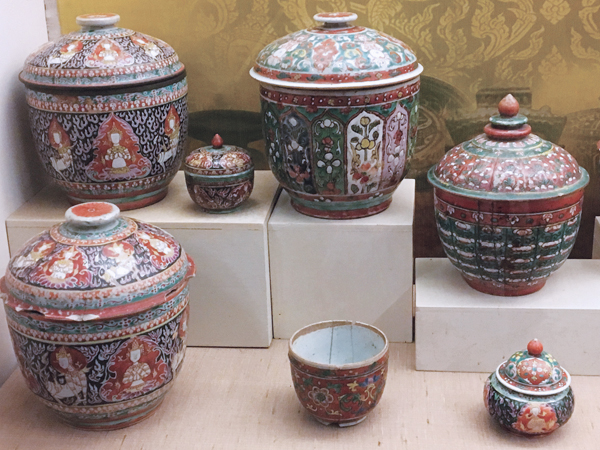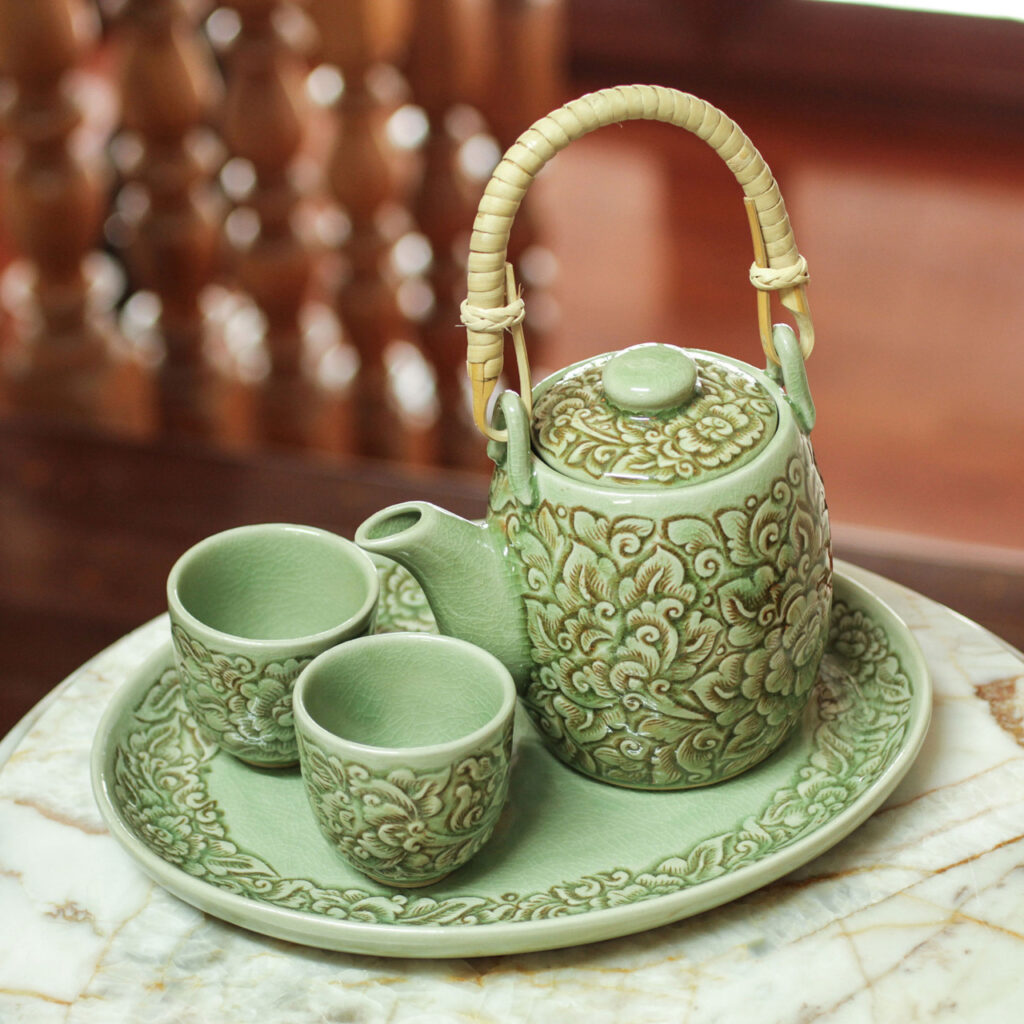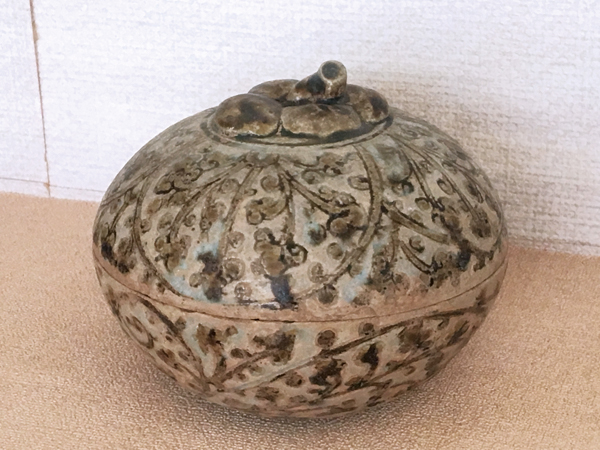In this article, you’ll learn about the intricacies of Thai ceramics and how they are deeply intertwined with Thai culture. From the elegant traditional designs to the intricate production process, you’ll gain a deeper understanding of the artistry and craftsmanship that goes into creating these beautiful ceramics.
Thai ceramics have long been recognized as a cultural treasure, and they are a must-see for any traveler visiting Thailand. The article will take you on a journey to different cities in Thailand, where you can explore the vibrant ceramic scene and admire the stunning creations. Additionally, you’ll discover how Thai ceramics have become an important part of the country’s tourism industry, attracting visitors from all over the world. From learning about the historical significance of certain ceramic styles to understanding the techniques used in their creation, this article will leave you with a newfound appreciation for the art of Thai ceramics and its place within the cultural fabric of Thailand.
Overview of Thai Ceramics
Thai ceramics have a rich and vibrant history that spans centuries. These exquisite pieces of art have gained international recognition for their intricate designs and impeccable craftsmanship. From traditional styles that have been passed down through generations, to contemporary innovations that push the boundaries of ceramic art, Thai ceramics have become an integral part of the country’s cultural heritage.
In this article, we will take you on a journey into the world of Thai ceramics, exploring its history, significance in Thai culture, materials and techniques used, famous artists, its role in Thai Buddhism, modern design applications, revitalization efforts, workshops and classes, museums and galleries, collecting and appreciating, festivals and events, sustainable development initiatives, and even how you can bring a piece of this cultural treasure home as a souvenir or gift. So, buckle up and get ready to immerse yourself in the beauty and intricacies of Thai ceramics.
History and Origins of Thai Ceramics
The origins of Thai ceramics can be traced back to the prehistoric period, with archaeological discoveries in Ban Chiang providing evidence of early pottery production. Dating back to around 2000 BCE, the pottery of Ban Chiang showcases the remarkable skills and techniques of the ancient inhabitants of Thailand. These early ceramics were primarily used for daily and ritualistic purposes, with their distinctive red-brown color and intricate decorations becoming hallmarks of Thai ceramic art.
As time passed, Thailand’s proximity to important trade routes allowed for cultural exchange and the emergence of new influences in ceramic production. During the Sukhothai and Ayutthaya periods (13th to 18th century), Thai ceramics began to exhibit more diverse styles and techniques, drawing inspiration from nearby regions such as China and Persia. These influences paved the way for the development of unique Thai ceramic styles, such as the renowned Sangkhalok ware and celadon pottery.
Significance of Thai Ceramics in Thai Culture
Thai ceramics hold deep cultural and historical significance in Thailand. These exquisite pieces of art have been used for various purposes, including religious rituals, royal ceremonies, and everyday household items. In Thai culture, ceramic pieces were often regarded as sacred objects that brought good luck, prosperity, and protection.
Furthermore, Thai ceramics played a crucial role in preserving and promoting Thai identity and heritage. With their unique designs and distinctive styles, Thai ceramics became a symbol of national pride and artistic excellence. The intricate patterns, vibrant colors, and meticulous craftsmanship reflected the country’s rich cultural heritage and artistic traditions.
Materials and Techniques Used in Thai Ceramics
Thai ceramics are crafted using a variety of materials and techniques, each contributing to the unique characteristics of the final product. The primary materials used in Thai ceramics include clay, glaze, and pigments. Clay is sourced from various regions of Thailand, each known for its distinct qualities and colors. The quality of the clay greatly impacts the final appearance and durability of the ceramic piece.
The techniques employed in Thai ceramic production are a testament to the skill and expertise of Thai artisans. Traditional techniques such as wheel throwing and hand molding are still widely practiced, alongside more modern approaches like slip casting and press molding. These time-honored techniques, passed down through generations, allow for the meticulous shaping, carving, and detailing that make Thai ceramics truly breathtaking.
Traditional Thai Ceramic Styles
Thai ceramics encompass a wide array of styles, each with its own unique characteristics and history. Here are a few notable traditional Thai ceramic styles that have left an indelible mark on the country’s artistic heritage.
Ban Chiang Pottery
The pottery of Ban Chiang, as mentioned earlier, holds immense historical significance in Thai ceramic art. The distinct red-brown color and intricate patterns found on Ban Chiang pottery showcases the skill and creativity of ancient Thai artisans. These ceramics were often used for daily functions, such as storing food and water, as well as for religious and ritualistic purposes.
Sangkhalok Ware
Sangkhalok ware, also known as “greenware,” gained popularity during the 14th to 16th centuries. This style of Thai ceramics was heavily influenced by Chinese ceramic traditions, particularly the Song and Yuan dynasties. Sangkhalok ware is characterized by its greenish-blue glaze and simple, yet elegant, designs. These ceramics were widely exported throughout Southeast Asia and beyond, becoming highly coveted objects of trade.
Celadon Pottery
Celadon pottery, another significant style of Thai ceramics, is renowned for its delicate green glaze and intricate carved designs. This style originated in China but found its way to Thailand, where it evolved and developed its distinct Thai aesthetic. Celadon pottery requires exceptional skill and precision, as the glaze must be applied evenly to achieve the desired effect. The subtle variations in color and the intricate carvings make celadon pottery a true masterpiece of Thai ceramic art.
Famous Thai Ceramics Artists
Thai ceramics artists have made significant contributions to the field, showcasing their talent, skills, and creativity through their extraordinary creations. Here are a few notable artists who have left an indelible mark on Thai ceramics.
Somluk Pantiboon
Somluk Pantiboon is a celebrated Thai ceramics artist known for his innovative approach to traditional pottery. His unique creations blend traditional techniques with modern forms, creating mesmerizing pieces that push the boundaries of ceramic art. Through his work, Somluk Pantiboon has garnered international recognition and has been a driving force in revitalizing Thai ceramics.
Soraya Osamu
Soraya Osamu is another influential figure in the world of Thai ceramics. Her creations are a fusion of Thai and Japanese aesthetics, reflecting her multicultural background. The delicacy and beauty of her pieces, combined with her exceptional technical skills, have earned her numerous accolades and exhibitions around the world.
Thawan Duchanee
Thawan Duchanee is renowned for his stunning ceramic sculptures depicting Buddhist and mythological figures. His works often feature intricate details and intricate forms, capturing the spiritual essence of Thai culture. Thawan Duchanee’s contributions to Thai ceramics have been highly regarded, cementing his place as one of the most influential ceramic artists in Thailand.
The Role of Thai Ceramics in Thai Buddhism
Thai ceramics have deep-rooted connections to the country’s predominant religion, Theravada Buddhism. Ceramics have long been used to create sculptures of Buddhist deities and ceremonial objects used in Buddhist rituals. These ceramic sculptures and objects serve as focal points of veneration, attracting devotees and pilgrims from all walks of life.
Ceramic Sculptures of Buddhist Deities
Thai ceramic artists have mastered the art of sculpting Buddhist deities, capturing the compassion, serenity, and wisdom associated with these divine figures. These sculptures, often made from clay or porcelain, are meticulously crafted, paying attention to every intricate detail. They are considered sacred objects, inviting devotees to contemplate and connect with the spiritual realm.
Ceremonial Objects Used in Buddhist Rituals
Ceramic objects also play a crucial role in Buddhist rituals and ceremonies. From incense burners and water bowls to offering vessels and candle holders, these objects are used to facilitate various rituals and symbolize reverence and devotion. The intricate designs and sacred symbolism infused in these ceramic objects make them integral to the practice of Thai Buddhism.

Thai Ceramics in Modern Design
Thai ceramics have found new expression in modern applications, extending beyond traditional uses. From interior design to fashion and accessories, Thai ceramics have become a sought-after element in contemporary design.
Incorporating Thai Ceramics in Interior Design
Thai ceramics add a touch of elegance and cultural heritage to interior spaces. From decorative vases and bowls to tiles and wall panels, these ceramic pieces can transform any room. Whether it’s a traditional Thai-inspired design or a more contemporary approach, Thai ceramics infuse a sense of artistry and sophistication into interior design.
Thai Ceramics in Fashion and Accessories
Thai ceramics have also made their way into the world of fashion and accessories. Jewelry, such as earrings, necklaces, and bracelets, adorned with ceramic charms or pendants, showcase the unique beauty of Thai ceramics. Additionally, ceramic buttons, buckles, and embellishments have become popular choices among fashion designers looking to incorporate Thai craftsmanship into their creations.
Revitalization of Thai Ceramics
Efforts to preserve and revitalize traditional ceramic techniques have gained momentum in recent years. Recognizing the importance of preserving this cultural heritage, various organizations and individuals have made significant strides in raising awareness and promoting the sustainability of Thai ceramics.
Efforts to Preserve Traditional Ceramic Techniques
Numerous initiatives have been launched to ensure the preservation of traditional ceramic techniques in Thailand. These efforts include workshops, training programs, and collaborations between experienced artisans and aspiring ceramic artists. By passing down knowledge and skills to the younger generations, traditional techniques and craftsmanship are kept alive.
Promoting Thai Ceramics as a Cultural Heritage
The promotion of Thai ceramics as a cultural heritage has been a key focus of organizations, museums, and galleries in Thailand. Through exhibitions, educational programs, and government support, the significance of Thai ceramics in the country’s culture is being highlighted and celebrated. This increased awareness has led to a growing appreciation of Thai ceramics, both locally and internationally.

Thai Ceramics Workshops and Classes
For those interested in learning the art of Thai ceramics, workshops and classes offer a hands-on experience to develop skills and explore the creative process behind this ancient craft.
Participating in Thai Ceramics Workshops
Various ceramic studios and organizations in Thailand offer workshops where participants can learn basic techniques in ceramic production. These workshops provide a unique opportunity to work alongside experienced ceramic artists and gain insights into their creative process. From molding and shaping to glazing and firing, participants get to experience the entire ceramic-making journey firsthand.
Learning Thai Ceramics Techniques
For those looking to delve deeper into the world of Thai ceramics, longer-term courses and programs are available. These comprehensive learning experiences allow participants to develop advanced skills and explore various techniques and styles. With guidance from experienced instructors, students can hone their craftsmanship and create their own unique ceramic pieces.
Exploring Thai Ceramics Museums and Galleries
To truly appreciate the beauty and intricacies of Thai ceramics, a visit to the museums and galleries dedicated to this art form is a must.
National Museum of Thai Ceramics
The National Museum of Thai Ceramics, located in Bangkok, is a treasure trove of Thai ceramic art. The museum houses an impressive collection of ceramics, ranging from ancient pieces to contemporary works. Visitors can learn about the history, techniques, and cultural significance of Thai ceramics through informative exhibits and interactive displays.
Ceramic Art and Culture Center
The Ceramic Art and Culture Center, another prominent institution in Bangkok, is dedicated to promoting ceramic art and culture in Thailand. The center hosts regular exhibitions, workshops, and lectures, providing a platform for artists, scholars, and enthusiasts to come together and celebrate Thai ceramics. The center’s vibrant atmosphere and diverse range of ceramic artworks make it a must-visit destination for anyone interested in this art form.

Collecting and Appreciating Thai Ceramics
Collecting Thai ceramics allows individuals to own a piece of Thailand’s rich artistic heritage. Here are some tips for aspiring collectors.
Tips for Collecting Thai Ceramics
When collecting Thai ceramics, it is essential to educate oneself about the different styles, periods, and artists. This knowledge will help collectors make informed decisions and ensure the authenticity and value of their acquisitions. Visiting reputable galleries, attending auctions, and engaging with experts in the field can provide invaluable insights for collectors.
Recognizing Authentic Thai Ceramic Pieces
Authentic Thai ceramics often bear distinctive characteristics that reflect their origins and historical periods. Familiarizing oneself with the unique features of different styles and the specific marks and signatures of renowned artists can help identify genuine pieces. Attention to details such as glaze quality, color, craftsmanship, and overall aesthetic will contribute to an accurate assessment of authenticity.
Thai Ceramics Festivals and Events
Thai ceramics festivals and events provide opportunities for artists, collectors, and enthusiasts to come together and celebrate the art form.
Annual Thai Ceramics Fair
The Annual Thai Ceramics Fair is a vibrant event that brings together artists, collectors, and ceramic enthusiasts from around the country. The fair showcases a wide range of ceramics, from traditional to contemporary, offering visitors a chance to admire and purchase unique pieces directly from the artists. Workshops, demonstrations, and lectures are also organized, allowing attendees to engage with the art form on a deeper level.
Ceramic Exhibitions and Trade Shows
In addition to the annual fair, various exhibitions and trade shows dedicated to Thai ceramics take place throughout the year. These events provide a platform for artists to showcase their works, connect with other ceramic enthusiasts, and gain exposure to a wider audience. Exhibitions range from small-scale local showcases to large-scale international events, further contributing to the visibility and appreciation of Thai ceramics.

Thai Ceramics and Sustainable Development
Sustainable development initiatives in the field of Thai ceramics aim to promote environmentally friendly practices and support local artisans and communities.
Promoting Eco-Friendly Ceramic Practices
Efforts are being made to promote eco-friendly ceramic practices, such as using locally sourced clay and natural glazes, as well as adopting energy-efficient kilns. These practices not only reduce environmental impact but also preserve traditional techniques and support the sustainability of the craft.
Supporting Local Artisans and Communities
By supporting local artisans and communities, sustainable development initiatives aim to ensure the preservation and continuation of Thai ceramics. This includes providing fair wages, creating opportunities for education and training, and fostering cultural exchange. By nurturing the talents of local artisans and empowering communities, the future of Thai ceramics is secured.
Thai Ceramics as Souvenirs and Gifts
Thai ceramics make meaningful and culturally significant souvenirs or gifts, allowing individuals to bring a piece of Thailand’s rich artistic heritage home.
Choosing Meaningful Thai Ceramic Souvenirs
When selecting Thai ceramics as souvenirs, consider the piece’s cultural significance and its alignment with personal preferences or interests. Traditional Thai designs, such as those found in Sangkhalok ware or celadon pottery, are often popular choices due to their historical importance. However, contemporary interpretations and unique creations by modern artists offer a fresh perspective on Thai ceramics that may resonate with individual tastes.
Thai Ceramic Gift Ideas
Thai ceramics also make excellent gifts for special occasions or to mark memorable events. From decorative vases and bowls to ceramic jewelry and tableware, the range of options ensures there is something for everyone. Personalizing the gift with a specific design or style can add a thoughtful touch, making it a cherished and meaningful keepsake.
The Contemporary Evolution of Thai Ceramics
Thai ceramics continue to evolve and adapt to contemporary sensibilities while staying true to their cultural heritage.
Innovations in Thai Ceramic Design
Contemporary Thai ceramic artists are constantly pushing the boundaries of design and experimentation. They explore new forms, techniques, and materials, incorporating modern influences while preserving the essence of Thai ceramics. The fusion of traditional craftsmanship with contemporary aesthetics results in innovative and captivating ceramic artworks.
Exploring Contemporary Thai Ceramic Artists
Exploring the works of contemporary Thai ceramic artists provides insight into the evolving nature of Thai ceramics. These artists draw inspiration from diverse sources, such as nature, Thai mythology, and global art movements. Each artist brings their unique perspective and artistic vision, contributing to the dynamic and ever-evolving world of Thai ceramics.
Conclusion
Exploring Thai ceramics is a fascinating journey into the intricate world of cultural heritage and artistic excellence. From their origins in prehistoric times to their place in Thai Buddhism, Thai ceramics have played an integral role in Thai culture and identity. By reviving traditional techniques, promoting sustainable practices, and fostering creativity and innovation, Thai ceramics continue to thrive and captivate audiences around the world.
Whether you choose to admire the beauty of Thai ceramics in museums and galleries, collect these cultural treasures, learn the art form through workshops, or incorporate them into your daily life and design, Thai ceramics invite you to connect with the rich artistic heritage of Thailand. So, embrace the beauty and intricacies of Thai ceramics and embark on a journey into the heart of Thai artistic expression.
